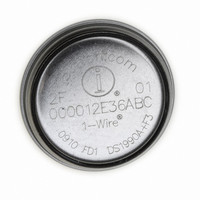DS1972-F3+ Maxim Integrated Products, DS1972-F3+ Datasheet - Page 16

DS1972-F3+
Manufacturer Part Number
DS1972-F3+
Description
IBUTTON EEPROM 1KBit F3
Manufacturer
Maxim Integrated Products
Series
iButton®r
Datasheet
1.DS1972-F3.pdf
(23 pages)
Specifications of DS1972-F3+
Rohs Information
IButton RoHS Compliance Plan
Memory Size
128B
Memory Type
EEPROM
Lead Free Status / RoHS Status
Lead free / RoHS Compliant
1024-Bit EEPROM iButton
To maximize the data throughput in a multidrop envi-
ronment, the Resume command is available. This com-
mand checks the status of the RC bit and, if it is set,
directly transfers control to the memory function com-
mands, similar to a Skip ROM command. The only way
to set the RC bit is through successfully executing the
Match ROM, Search ROM, or Overdrive-Match ROM
command. Once the RC bit is set, the device can
repeatedly be accessed through the Resume com-
mand. Accessing another device on the bus clears the
RC bit, preventing two or more devices from simultane-
ously responding to the Resume command.
On a single-drop bus this command can save time by
allowing the bus master to access the memory func-
tions without providing the 64-bit ROM code. Unlike the
normal Skip ROM command, the Overdrive-Skip ROM
command sets the DS1972 into the overdrive mode
(OD = 1). All communication following this command
must occur at overdrive speed until a reset pulse of
minimum 480µs duration resets all devices on the bus
to standard speed (OD = 0).
When issued on a multidrop bus, this command sets all
overdrive-supporting devices into overdrive mode. To
subsequently address a specific overdrive-supporting
device, a reset pulse at overdrive speed must be
issued followed by a Match ROM or Search ROM com-
mand sequence. This speeds up the time for the
search process. If more than one slave supporting
overdrive is present on the bus and the Overdrive-Skip
ROM command is followed by a read command, data
collision occurs on the bus as multiple slaves transmit
simultaneously (open-drain pulldowns produce a wired-
AND result).
The Overdrive-Match ROM command followed by a 64-
bit ROM sequence transmitted at overdrive speed
allows the bus master to address a specific DS1972 on
a multidrop bus and to simultaneously set it in overdrive
mode. Only the DS1972 that exactly matches the 64-bit
ROM sequence responds to the subsequent memory
function command. Slaves already in overdrive mode
from a previous Overdrive-Skip ROM or successful
Overdrive-Match ROM command remain in overdrive
mode. All overdrive-capable slaves return to standard
speed at the next reset pulse of minimum 480µs dura-
tion. The Overdrive-Match ROM command can be used
with a single device or multiple devices on the bus.
16
______________________________________________________________________________________
Overdrive-Match ROM [69h]
Overdrive-Skip ROM [3Ch]
Resume [A5h]
The DS1972 requires strict protocols to ensure data
integrity. The protocol consists of four types of signal-
ing on one line: reset sequence with reset pulse and
presence pulse, write-zero, write-one, and read-data.
Except for the presence pulse, the bus master initiates
all falling edges. The DS1972 can communicate at two
different speeds: standard speed and overdrive speed.
If not explicitly set into the overdrive mode, the DS1972
communicates at standard speed. While in overdrive
mode, the fast timing applies to all waveforms.
To get from idle to active, the voltage on the 1-Wire line
needs to fall from V
from active to idle, the voltage needs to rise from
V
voltage to make this rise is seen in Figure 10 as ε, and
its duration depends on the pullup resistor (R
and the capacitance of the 1-Wire network attached.
The voltage V
determining a logical level, not triggering any events.
Figure 10 shows the initialization sequence required to
begin any communication with the DS1972. A reset
pulse followed by a presence pulse indicates that the
DS1972 is ready to receive data, given the correct
ROM and memory function command. If the bus master
uses slew-rate control on the falling edge, it must pull
down the line for t
edge. A t
overdrive mode, returning the device to standard
speed. If the DS1972 is in overdrive mode and t
no longer than 80µs, the device remains in overdrive
mode. If the device is in overdrive mode and t
between 80µs and 480µs, the device resets, but the
communication speed is undetermined.
After the bus master has released the line it goes into
receive mode. Now the 1-Wire bus is pulled to V
through the pullup resistor or, in the case of a DS2482-
x00 or DS2480B driver, through the active circuitry.
When the threshold V
for t
the line low for t
master must test the logical state of the 1-Wire line at
t
The t
t
t
nication. In a mixed population network, t
be extended to minimum 480µs at standard speed and
48µs at overdrive speed to accommodate other 1-Wire
devices.
MSP
RSTH
PDHMAX
ILMAX
PDH
.
RSTH
is expired, the DS1972 is ready for data commu-
past the threshold V
and then transmits a presence pulse by pulling
, t
RSTL
PDLMAX
window must be at least the sum of
ILMAX
duration of 480µs or longer exits the
PDL
PUP
, and t
RSTL
. To detect a presence pulse, the
is relevant for the DS1972 when
TH
below the threshold V
is crossed, the DS1972 waits
+ t
RECMIN
TH
1-Wire Signaling
F
. The time it takes for the
to compensate for the
. Immediately after
RSTH
PUP
TL
. To get
RSTL
RSTL
should
) used
PUP
is
is













